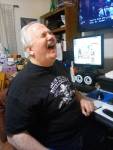Quoted Text
Greetings John,
On the footlaocker, please allow me some suggetions. I have one of my father's old jobs that was done for the Fleet Marines in the Naval workshops in WWII. His is plywood skinned. It has the brass latch & hasp in front and the padlock was attached with a small link chain attached to the hasp. At each end it has brass handles that float in framed end caps (so they don't stick out until you need to lift it). The cockade you have on top of the box lid is raised. This would interfere with stowage stacking. Maybe a decal? I have spares. The name would probably have been painted on the box lid too. Decals there as well?
Thanks Stephen ! This design seems to be standard among the commonwealth troops at the time.My father in law was a lieutenant in WW1 and a Captain in WW2 after the war he was given the rank of Major(aux). (post- mortem).It seems the officers and men had the same footlockers.
The reason I didn't use decals was because I was worried about their deterioration over time.Maybe the modern ones are better than what I remember years ago.I will leave that up to your judgement .The name plate and RFC roundel are important as they help to identify a lot about what is going on in the diorama.
The museum plans to do some audio/visual stuff in a storyboard sequence of left to right and have it recorded on a hand held device of some kind that each visitor will be given.I am supposed to do the English version and my wife the French.Now that the fourth diorama is almost finished I plan to spend more time on this aspect of the dioramas.What a wonderful time we live in for static storyboard dioramas to come to life in this unique way.
















